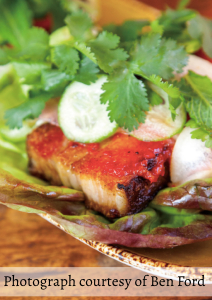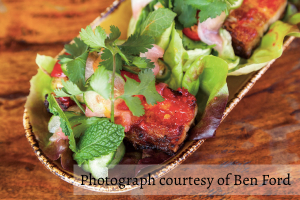New American Comfort
I have memories from my childhood of my mother and father packing the car for our annual summer stay in Wisconsin. Into the car went clothes, sports equipment, a cooler to store food for the long stretches of drive that lay ahead of us, and a box full of the staple foods we had grown accustomed to in Los Angeles and couldn’t live without. Tortillas, hot sauce and pinto beans would fill our coffers only to be replaced by Nueske’s bacon, wild blueberry preserves and hazelnuts for the return.
Things have changed. Today, we no longer worry about transporting a summer’s worth of tortillas and hot sauce 2,000 miles. Today, all those items and more crowd the shelves at any small-town grocery store making it a little easier to find those foods that give us comfort.
America is a great melting pot – a country where cultures and food have collided for centuries with new immigrants adding their touch to a cultural stew that we identify with as American cuisine. Initially settled by Europeans, the first bit of comfort new immigrants preserved in their new land often came in the form of food. Foods germinated from the seeds they brought with them from overseas. It took time, but with each successful crop an added stitch was sewn into the fabric of what we know now as American cuisine. Today we are seeing enormous changes to what we deem as American food. Having grown up in an environment where global cuisines are the norm, Millennials’ definition of “comfort food” is a lot different from that of previous generations, and this difference has helped to broaden the scope of present-day food culture.
As we have evolved with each new culinary experience, we find new foods we enjoy, foods we find solace and comfort in. For the most part they are the nostalgic dishes of our childhood. These are the foods that bring comfort to you, and this changes with each generation and with each wave of new Americans.
Long gone are the days of burgers being served on roller-skates, afternoon matinees, and firehouse cookouts. Today, it’s about food trucks, DirecTV and NASCAR, and the foods we choose to nurture ourselves with come in the form of new American classics born from the fusion cooking of the last 30 years.
No longer is American comfort food meatloaf and mashed potatoes. It’s not even matzo ball soup and a hot pastrami sandwich—my personal go-to when I need a little “food hug.” Today pho, kimchi pancakes, chile rellenos and pork belly lettuce wraps have joined the ranks of lobster rolls and barbequed ribs. America is more diverse than ever, and our interpretation of comfort food is based on factors ranging from cultural to geographical, and can be influenced by other factors such as whether or not our parents had an appreciation for food. That is still the case, and for the most part, comfort foods are still regional and local classics. However, those dishes are a generation away from going the way of other one-time American classics like ambrosia or noodle casseroles.
New York and Los Angeles, cities with the largest concentrations of ethnic diversity in the country, are traditionally where trends get their start, but smaller cities like Memphis, Denver and Minneapolis, traditionally too inland to benefit from that much diversity, now have their own wonderful stew of cultural diversity that rivals the largest of cities. Now they too have something to lend to the culinary landscape of American cuisine. Even smaller cities, like Orlando, Florida with its huge Middle Eastern influence or Portland, Oregon with its Thai scene, have added enough diversity to change the traditional perception of what American comfort food is.
Small town America is not that far behind. Where one might envision a whitewashed culinary scene, diversity is finding its way into rural America with some small towns actively pursuing new immigrants in hopes of reversing the effects caused by the disappearance in their agricultural and manufacturing sectors.
Where immigrants have settled, small towns are thriving. Bloomington, Indiana with only 80,000 inhabitants has more ethnic restaurants per capita than any other place in the United States, and Greensboro, North Carolina, a city of 275,000 residents, houses an immigrant population that represents more than 140 countries of origin and who speaks over 120 languages. Historically a Quaker community, Greensboro has welcomed refugees from Vietnam, the Middle East, Bhutan, Myanmar, the Democratic Republic of Congo, Sudan and Ethiopia for the last 30 years, and of course they brought their native culture’s flavors and foods with them.
Along the way we’ve developed a culinary appreciation for various cultures, foods and, by extension, the cultures that bring us these foods. However, America, like other spots in the world, is developing a heightened philosophy of patriotism that threatens to change our views on ethnicity, culture and - god forbid - homogenize our tastes. Meanwhile, multiculturalism, which asked us to celebrate the cultures that brought us every delicacy from samosas to goulash, is waning and being replaced by evermore conservative, assimilation-oriented thinking. Finding common ground with those different from ourselves has never been more important. Food is still one of the best ways to learn a culture, and in this tenuous period in our history it’s important that we continue to find acceptance through cuisine. The fact that we find happiness through our stomachs does help, and a new version of what we consider to be comfort food awaits us over the next horizon. tj
Pork Belly Lettuce Wraps
- Ingredients:
- 2 lbs. pork belly
- 12-14 lettuce wraps
- Marinade:
- ¼ tablespoon sugar
- 1 cup water
- ½ cup soy sauce
- ¼ cup sake
- 4 garlic cloves minced
- 1 tablespoon minced ginger
- 3 tablespoons seasoned rice vinegar
- 1 teaspoon sesame oil
- 3 tablespoons agave nectar
- Chili Glaze:
- 3 tablespoons chili paste
- 3 tablespoons seasoned rice vinegar
- 1 tablespoon honey
- pickled watermelon
- ¼ medium watermelon including the rind
- ½ inch red flesh
- ½ cup rice wine vinegar
- ¼ cup water
- ½ cup sugar
- 2 ½ teaspoons kosher salt
- 1 whole star anise
- 1” knob of fresh ginger, peeled
- Garnishes:
- 1 wedge pickled watermelon, sliced thin
- 1 Persian cucumber, sliced thin
- ½ Serrano Ham, sliced thin
- 1 bunch cilantro, leaves picked
- 1 bunch fresh mint, leaves picked
- lime wedges

Preparation:
Step 1: Make pickled watermelon.
a. Peel the watermelon leaving the green inner rind intact. Cut the watermelon rind into 1-inch-thick slices.
b. Combine the vinegar, water, sugar, salt, star anise and ginger in a saucepan and bring to a boil, stirring to dissolve the sugar. Add the watermelon rind and boil for 1 minute, then carefully transfer to a container. Cool and then refrigerate.
Step 2: Combine all ingredients for marinade and marinate pork belly for 2 hours.
Step 3: Preheat smoker to 230 degrees.
Step 4: Smoke belly for 2 hours. (Note: If you don’t have a smoker, go straight to the next step and braise in oven for 4 hours instead of 3.)
Step 5: Preheat oven to 275 degrees.
Step 6: Remove from smoker and place in a roasting pan, fat side up. Add the marinade and add mixture to the bottom of the pan. Liquid should reach ¾ of the way up the pork belly or what I like to call “gator.” Cover pan with aluminum foil. Braise in oven for 3 hours. Remove from liquid and let cool.
Step 7: Slice pork belly ½” thick and 3” long. In a hot pan or grill, sear the pork belly on both sides.
Step 8: Combine in large bowl, add garnishes and toss to mix. Set aside until ready to serve.
To Serve: Place one piece of pork belly on each lettuce cup. Spoon chili glaze over each piece and top with garnishes. Serve with a wedge of lime.
The complete article can be found in Issue #279 of the Tokyo Journal.













